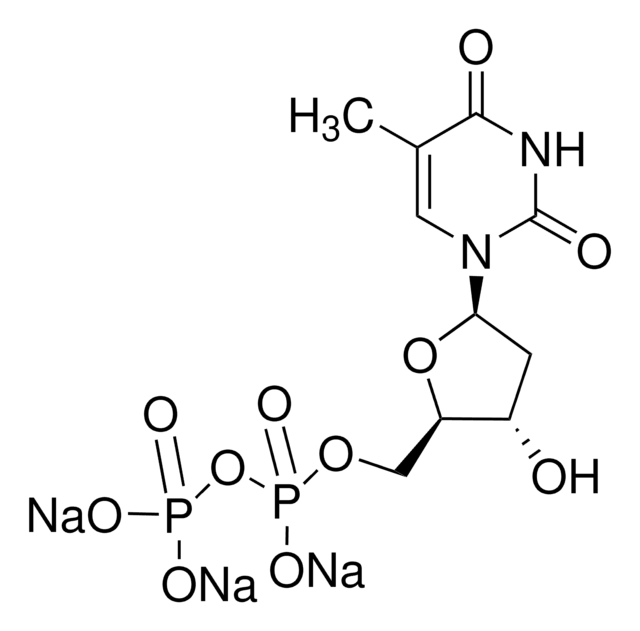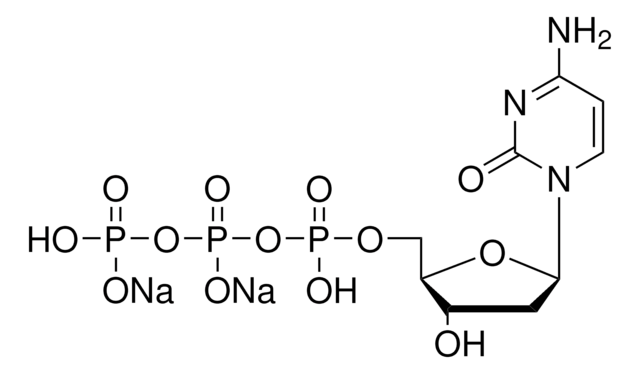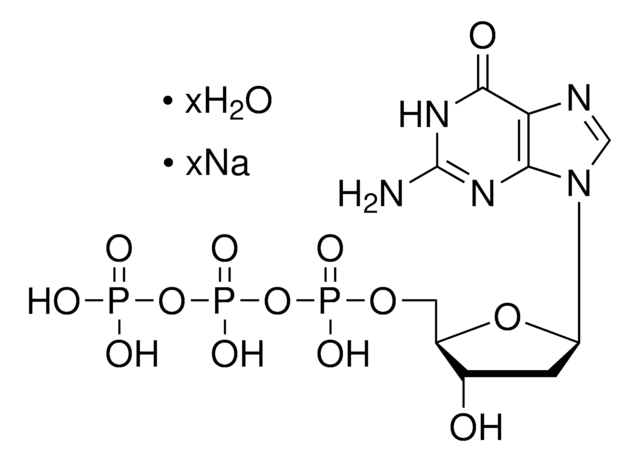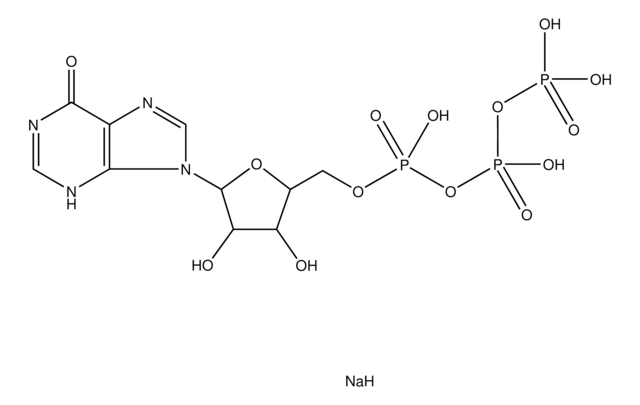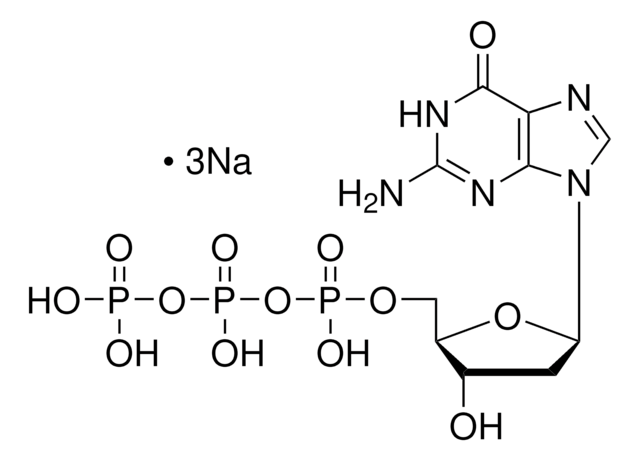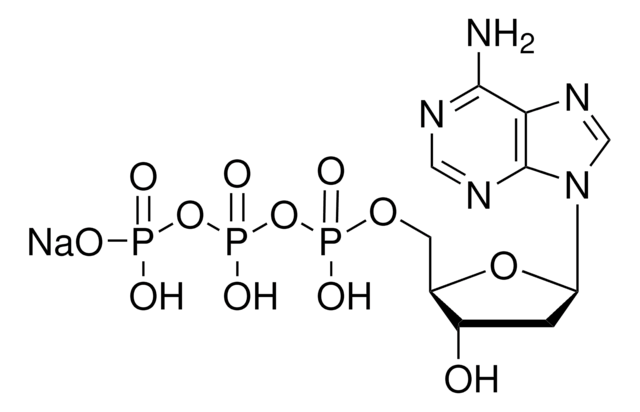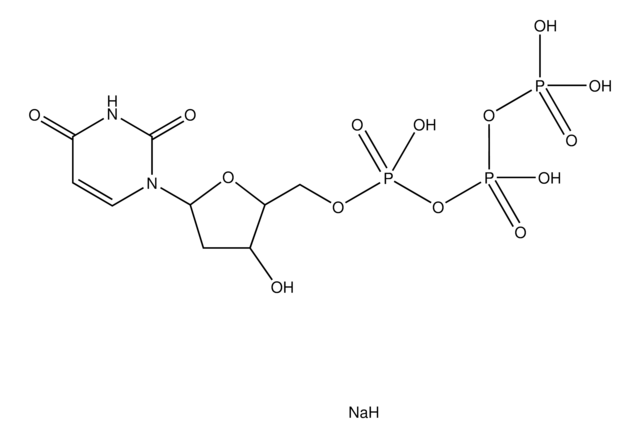T0251
Thymidine 5′-triphosphate sodium salt
≥96%
Synonym(s):
TTP, dTTP
Sign Into View Organizational & Contract Pricing
All Photos(1)
About This Item
Empirical Formula (Hill Notation):
C10H16N2O14P3Na
CAS Number:
Molecular Weight:
504.15
MDL number:
UNSPSC Code:
41106305
PubChem Substance ID:
NACRES:
NA.51
Recommended Products
Quality Level
Assay
≥96%
shipped in
dry ice
storage temp.
−20°C
InChI
1S/C10H17N2O14P3.Na.H/c1-5-3-12(10(15)11-9(5)14)8-2-6(13)7(24-8)4-23-28(19,20)26-29(21,22)25-27(16,17)18;;/h3,6-8,13H,2,4H2,1H3,(H,19,20)(H,21,22)(H,11,14,15)(H2,16,17,18);;
InChI key
KAELIXTVSANDSE-UHFFFAOYSA-N
Looking for similar products? Visit Product Comparison Guide
Application
Thymidine 5′-triphosphate (dTTP) is one of the four natural deoxynucleotides, along with deoxyadenosine 5′-triphosphate (dATP), deoxyguanosine 5′-triphosphate (dGTP) and deoxycytosine 5′-triphosphate (dCTP) used for the biosynthesis of deoxyribonucleic acids by DNA polymerases and reverse transcriptases. Deoxy-TTP may also be used as a substrate to study the specificity and kinetics of thymidine-triphosphatase(s) (EC 3.6.1.39) and other dTTP hydrolyzing activities.
Thymidine 5′-triphosphate sodium salt has been used:
- in the quenching ability test for dual-aptamer and multiple-nucleotide detection based on a multiple-aptamer/GO-nS complex
- to study protein-metabolite interactions in the central metabolism of Escherichia coli
- in a polymerase chain reaction (PCR) product formation using AM-toxin primers
Biochem/physiol Actions
Thymidine triphosphate is a building block of DNA. It acts as an allosteric regulator of other nucleotides′ metabolism.
Storage Class Code
11 - Combustible Solids
WGK
WGK 3
Flash Point(F)
Not applicable
Flash Point(C)
Not applicable
Choose from one of the most recent versions:
Already Own This Product?
Find documentation for the products that you have recently purchased in the Document Library.
Customers Also Viewed
Chien-Sung Tsai et al.
American journal of translational research, 8(12), 5338-5353 (2017-01-13)
Eotaxin-2 is a potent chemoattractant. High concentration of eotaxin-2 triggers the inflammation and tumor metastasis. Inhibition of eotaxin-2 may protect experimental atherogenesis although the mechanism is still unclear. Toll-like receptor 4 (TLR4) plays a major role mediating vascular inflammation, which
Felicitas Rataj et al.
Molecular biology of the cell, 27(24), 3841-3854 (2016-10-07)
TPA-inducible sequence 11b/butyrate response factor 1 (TIS11b/BRF1) belongs to the tristetraprolin (TTP) family of zinc-finger proteins, which bind to mRNAs containing AU-rich elements in their 3'-untranslated region and target them for degradation. Regulation of TTP family function through phosphorylation by
Ji Eun Park et al.
PloS one, 12(7), e0181933-e0181933 (2017-07-22)
To determine if perfusion in surgical cavity wall enhancement (SCWE) obtained in early post-treatment MR imaging can stratify time-to-progression (TTP) in glioblastoma. This study enrolled 60 glioblastoma patients with more than 5-mm-thick SCWEs as detected on contrast-enhanced MR imaging after
Zhuangsheng Liu et al.
Journal of magnetic resonance imaging : JMRI, 50(3), 847-857 (2019-02-19)
Lymphovascular invasion (LVI) status facilitates the selection of optimal therapeutic strategy for breast cancer patients, but in clinical practice LVI status is determined in pathological specimens after resection. To explore the use of dynamic contrast-enhanced (DCE)-magnetic resonance imaging (MRI)-based radiomics
Merel M C Lambregts et al.
PloS one, 14(1), e0208819-e0208819 (2019-01-03)
Blood cultures are considered the gold standard to distinguish bacteremia from non-bacteremic systemic inflammation. In current clinical practice, bacteraemia is considered unlikely if blood cultures have been negative for 48-72 hours. Modern BC systems have reduced this time-to-positivity (TTP), questioning
Our team of scientists has experience in all areas of research including Life Science, Material Science, Chemical Synthesis, Chromatography, Analytical and many others.
Contact Technical Service